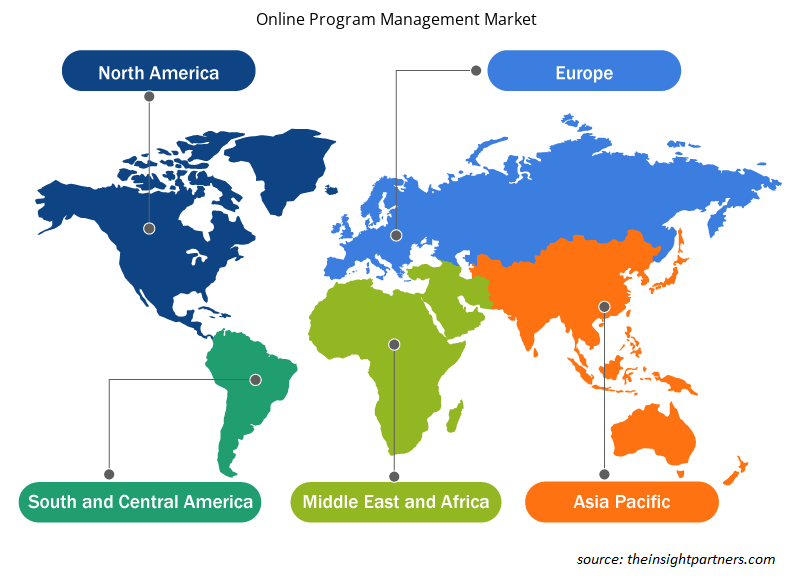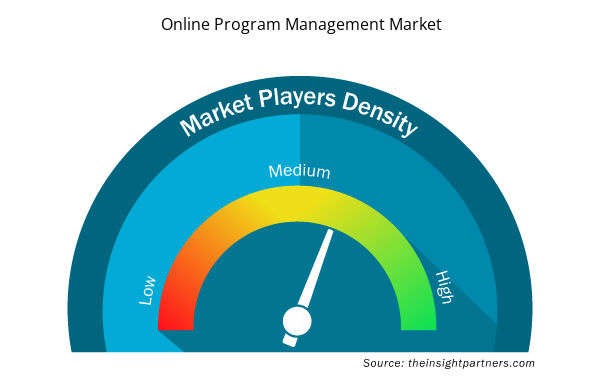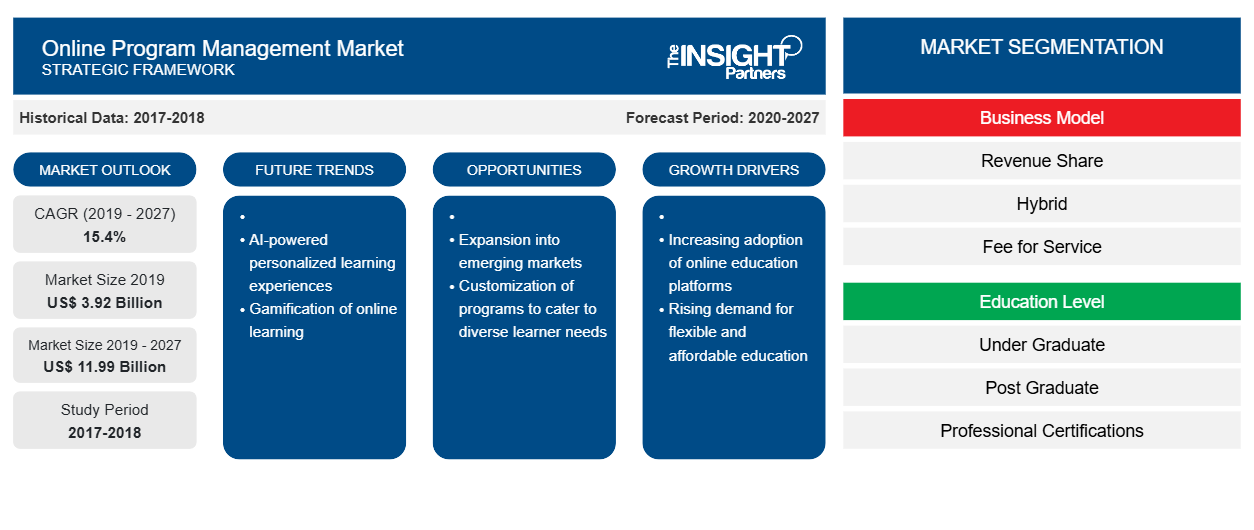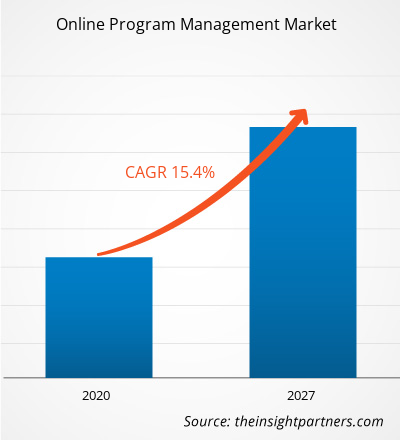2019 年在线项目管理市场价值为 39.163 亿美元,预计 2020 年至 2027 年的复合年增长率为 15.4%,到 2027 年达到 119.864 亿美元。
在线课程管理 (OPM) 包括支持学生、处理注册、进行市场研究和分析,并提供最新的营销技术基础设施。参与在线课程管理的团队包括数字营销专家、数据分析师、教育技术专家、网络开发人员和学生支持专家,旨在为学生创造一个轻松的流程。在线学位现在很常见,由几所学院和大学提供,每年,所有机构的学生都会报名参加在线课程。在线课程管理市场在高度分散和竞争激烈的市场中运作。随着该市场的领先公司继续扩大其目标市场,通过扩大其现有产品,多样化其客户群,所有知名参与者都面临着越来越激烈的竞争,既有来自初创公司的竞争,也有来自全球领先的成熟公司的竞争。价值链中的几家公司正在收购市场上的其他参与者,以保持其在市场中的地位并为客户提供高效的服务。在线课程管理提供商的主要公司位于北美,主要是美国。然而,市场在亚太地区的渗透率很高。
北美的多家公司为高等教育机构和大学提供在线项目管理解决方案,这些解决方案在教育领域得到广泛认可。对电子学习的需求增加以及对有效学习的日益重视引发了该地区教育市场的增长。政府不断推出的举措(如教育部的联邦学生援助计划)以及私营和公共机构利用技术进步开发创新在线项目管理解决方案的趋势日益增强,推动了在线项目管理市场的增长。
定制此报告以满足您的需求
您可以免费定制任何报告,包括本报告的部分内容、国家级分析、Excel 数据包,以及为初创企业和大学提供优惠和折扣
- 获取此报告的关键市场趋势。这个免费样品将包括数据分析,从市场趋势到估计和预测。
市场洞察
在线教育需求的不断增长推动了在线课程管理市场的增长
在线学习正在成为教育领域不可或缺的一部分。越来越多的学生寻求灵活的证书、课程和学位课程形式,以支持职业安置和深造,这推动了在线课程的招生。在校内就读的学生也专注于在入学期间注册混合到完全在线的课程。在线学士学位在学生中蓬勃发展,因为许多著名的大型机构正在转向各种在线学位课程,因为在线学位课程在学习体验中提供了高质量的技术支持。此外,当今的研究生正积极专注于攻读虚拟课程以完成他们的高等教育。例如,MBA 课程的远程学习越来越受欢迎,在线 MBA 课程的数量逐年稳步增长。随着对虚拟课程的需求不断增加,公立和非营利大学对此类课程的注册人数正在增加,这预计将促进在线课程管理市场的增长。此外,对职业相关技能发展和终身学习的不断增长的需求在推动在线课程的发展方面发挥着重要作用。对于在线课程提供商而言,证书课程购买者覆盖了很大一部分,因为许多学生选择在线课程来提高他们的技能知识,而这些课程与行业标准相关。通过获得与其领域相关的认证,专业人士现在可以提高他们对公司的价值以及他们的职位。这一雄心勃勃的选择有望让他们了解技术、行业趋势以及世界各地不断发展的许多其他主题领域。通过选择不同的合适课程来保持相关性和教育水平,为当前情况下的个人职业发展提供了最佳机会。例如,数据分析在学生中越来越受欢迎,许多在线教育门户网站和大学都设计了一系列关于数据分析和数据市场研究的课程。因此,对在线学位和专业课程的需求不断增长,推动了在线课程管理市场的增长。
商业模式洞察
在商业模式方面,收入份额在全球在线项目管理市场中占据最大份额。收入份额是一种长期的、机构范围的合作模式,需要机构对项目的执行和维持进行有限的投资。在这种模式下,合作机构的财务风险有限,因为 OPM 提供商提供了大部分投资资本。
教育水平洞察
在线项目管理市场按应用分为本科、研究生、专业认证和其他。研究生部分在全球在线项目管理市场中占据主导地位。
COVID-19 对在线项目管理市场的影响
新冠病毒已经影响了全球的教育系统。这导致许多大学和学校关闭。这对学校和学院的运营产生了不利影响。为了应对因新冠疫情而关闭的学校和大学,联合国教科文组织建议使用开放式教育应用程序和在线远程学习课程进行远程教学。这为在线课程管理服务提供商带来了巨大的机会。然而,缺乏互联网连接和支持基础设施仍然是一个挑战。
并购策略是公司普遍采用的策略,以扩大其全球业务范围并满足不断增长的需求。这种策略在北美最为常见。以下列出了一些近期的收购案例;
2018 年:Wiley 收购了 The Learning House, Inc。该公司的业务范围扩大到提供在线课程管理服务,包括研究生和本科课程、短期课程、训练营和其他面向国际学生的服务、教师专业发展服务等。2017
年:2U 收购了 Get Educated International Proprietary Limited。该公司收购了 Get Educated International Proprietary Limited。因此,该公司现在通过两个可报告的部门管理其业务。
在线项目管理市场区域洞察
Insight Partners 的分析师已详细解释了预测期内影响在线项目管理市场的区域趋势和因素。本节还讨论了北美、欧洲、亚太地区、中东和非洲以及南美和中美洲的在线项目管理市场细分和地理位置。

- 获取在线项目管理市场的区域特定数据
在线项目管理市场报告范围
| 报告属性 | 细节 |
|---|---|
| 2019 年市场规模 | 39.2亿美元 |
| 2027 年市场规模 | 119.9亿美元 |
| 全球复合年增长率(2019 - 2027) | 15.4% |
| 史料 | 2017-2018 |
| 预测期 | 2020-2027 |
| 涵盖的领域 | 按商业模式
|
| 覆盖地区和国家 | 北美
|
| 市场领导者和主要公司简介 |
|
在线项目管理市场参与者密度:了解其对业务动态的影响
在线项目管理市场正在快速增长,这得益于最终用户需求的不断增长,这些需求源于消费者偏好的不断变化、技术进步以及对产品优势的认识不断提高等因素。随着需求的增加,企业正在扩大其产品范围,进行创新以满足消费者的需求,并利用新兴趋势,从而进一步推动市场增长。
市场参与者密度是指在特定市场或行业内运营的企业或公司的分布情况。它表明在给定市场空间中,相对于其规模或总市场价值,有多少竞争对手(市场参与者)存在。
在线项目管理市场的主要运营公司有:
- 2U 公司
- 学术伙伴关系
- 阿波利冬
- Bisk 教育公司
- 黑板公司
免责声明:上面列出的公司没有按照任何特定顺序排列。

- 获取在线项目管理市场顶级关键参与者概览
在线项目管理市场 – 按商业模式
- 收益分成
- 杂交种
- 服务费
在线项目管理市场 – 按教育水平
- 本科
- 研究生
- 专业认证
- 其他的
全球在线项目管理市场(按区域)
北美
- 我们
- 加拿大
- 墨西哥
欧洲
- 法国
- 德国
- 意大利
- 英国
- 俄罗斯
- 欧洲其他地区
亚太地区
- 中国
- 印度
- 韩国
- 日本
- 澳大利亚
- 亚太其他地区
中东和非洲
- 南非
- 沙特阿拉伯
- 阿联酋
- 中东和非洲其他地区
南美洲
- 巴西
- 阿根廷
- 南美洲其他地区
公司简介
- 2U 公司
- 学术伙伴关系
- 阿波利冬
- Bisk 教育公司
- 黑板公司
- 基路教育
- 面条伙伴
- 在线教育服务
- 培生集团
- 威利教育服务
- 历史分析(2 年)、基准年、预测(7 年)及复合年增长率
- PEST 和 SWOT 分析
- 市场规模价值/数量 - 全球、区域、国家
- 行业和竞争格局
- Excel 数据集


- Health Economics and Outcome Research (HEOR) Services Market
- Microcatheters Market
- Intraoperative Neuromonitoring Market
- Constipation Treatment Market
- Flexible Garden Hoses Market
- Blood Collection Devices Market
- Precast Concrete Market
- Long Read Sequencing Market
- Non-Emergency Medical Transportation Market
- Radiopharmaceuticals Market

Report Coverage
Revenue forecast, Company Analysis, Industry landscape, Growth factors, and Trends

Segment Covered
This text is related
to segments covered.

Regional Scope
North America, Europe, Asia Pacific, Middle East & Africa, South & Central America

Country Scope
This text is related
to country scope.
常见问题
The revenue share is the leading business model in the market. The revenue share model is attractive owing to low capital investment requirements, and broad resources and technological expertise availability, for planning, designing, and launching online higher education programs. This model provides an adequate amount of consulting; infrastructure support, marketing resources, and student support services, as well as accelerates recruitments worldwide.
The OPM partners help the institutes in leveraging their deep strategic insight, analytics, data, and vast resources to expect change and take benefit of new opportunities. Also, these players support to plan for demographic change through designing high-demand programs that register students across traditional geographic boundaries. The rising focus of institutes to collaborate with OPM provides to control risks associated with the online programs is propelling the growth of OPM market.
The North America region led the online program management market in 2019. The rising initiatives by governments such as Department's federal student aid programs and increasing trend of leveraging technological advancements for developing innovative online program management solutions by the private and the public institutes drive the growth of the online program management market in the region. The presence of various renowned educational institutes, such as Harvard University, Stanford University, University of Toronto, University of British Columbia, and the National Autonomous University of Mexico, is also contributing to the market growth.
Trends and growth analysis reports related to Technology, Media and Telecommunications : READ MORE..
The List of Companies - Online Program Management Market
- 2U, Inc.
- Academic Partnerships
- Apollidon
- Bisk Education, Inc.
- Blackboard Inc.
- Keypath Education
- Noodle Partners
- Online Education Services
- Pearson PLC
- Wiley Education Services
The Insight Partners performs research in 4 major stages: Data Collection & Secondary Research, Primary Research, Data Analysis and Data Triangulation & Final Review.
- Data Collection and Secondary Research:
As a market research and consulting firm operating from a decade, we have published and advised several client across the globe. First step for any study will start with an assessment of currently available data and insights from existing reports. Further, historical and current market information is collected from Investor Presentations, Annual Reports, SEC Filings, etc., and other information related to company’s performance and market positioning are gathered from Paid Databases (Factiva, Hoovers, and Reuters) and various other publications available in public domain.
Several associations trade associates, technical forums, institutes, societies and organization are accessed to gain technical as well as market related insights through their publications such as research papers, blogs and press releases related to the studies are referred to get cues about the market. Further, white papers, journals, magazines, and other news articles published in last 3 years are scrutinized and analyzed to understand the current market trends.
- Primary Research:
The primarily interview analysis comprise of data obtained from industry participants interview and answers to survey questions gathered by in-house primary team.
For primary research, interviews are conducted with industry experts/CEOs/Marketing Managers/VPs/Subject Matter Experts from both demand and supply side to get a 360-degree view of the market. The primary team conducts several interviews based on the complexity of the markets to understand the various market trends and dynamics which makes research more credible and precise.
A typical research interview fulfils the following functions:
- Provides first-hand information on the market size, market trends, growth trends, competitive landscape, and outlook
- Validates and strengthens in-house secondary research findings
- Develops the analysis team’s expertise and market understanding
Primary research involves email interactions and telephone interviews for each market, category, segment, and sub-segment across geographies. The participants who typically take part in such a process include, but are not limited to:
- Industry participants: VPs, business development managers, market intelligence managers and national sales managers
- Outside experts: Valuation experts, research analysts and key opinion leaders specializing in the electronics and semiconductor industry.
Below is the breakup of our primary respondents by company, designation, and region:

Once we receive the confirmation from primary research sources or primary respondents, we finalize the base year market estimation and forecast the data as per the macroeconomic and microeconomic factors assessed during data collection.
- Data Analysis:
Once data is validated through both secondary as well as primary respondents, we finalize the market estimations by hypothesis formulation and factor analysis at regional and country level.
- Macro-Economic Factor Analysis:
We analyse macroeconomic indicators such the gross domestic product (GDP), increase in the demand for goods and services across industries, technological advancement, regional economic growth, governmental policies, the influence of COVID-19, PEST analysis, and other aspects. This analysis aids in setting benchmarks for various nations/regions and approximating market splits. Additionally, the general trend of the aforementioned components aid in determining the market's development possibilities.
- Country Level Data:
Various factors that are especially aligned to the country are taken into account to determine the market size for a certain area and country, including the presence of vendors, such as headquarters and offices, the country's GDP, demand patterns, and industry growth. To comprehend the market dynamics for the nation, a number of growth variables, inhibitors, application areas, and current market trends are researched. The aforementioned elements aid in determining the country's overall market's growth potential.
- Company Profile:
The “Table of Contents” is formulated by listing and analyzing more than 25 - 30 companies operating in the market ecosystem across geographies. However, we profile only 10 companies as a standard practice in our syndicate reports. These 10 companies comprise leading, emerging, and regional players. Nonetheless, our analysis is not restricted to the 10 listed companies, we also analyze other companies present in the market to develop a holistic view and understand the prevailing trends. The “Company Profiles” section in the report covers key facts, business description, products & services, financial information, SWOT analysis, and key developments. The financial information presented is extracted from the annual reports and official documents of the publicly listed companies. Upon collecting the information for the sections of respective companies, we verify them via various primary sources and then compile the data in respective company profiles. The company level information helps us in deriving the base number as well as in forecasting the market size.
- Developing Base Number:
Aggregation of sales statistics (2020-2022) and macro-economic factor, and other secondary and primary research insights are utilized to arrive at base number and related market shares for 2022. The data gaps are identified in this step and relevant market data is analyzed, collected from paid primary interviews or databases. On finalizing the base year market size, forecasts are developed on the basis of macro-economic, industry and market growth factors and company level analysis.
- Data Triangulation and Final Review:
The market findings and base year market size calculations are validated from supply as well as demand side. Demand side validations are based on macro-economic factor analysis and benchmarks for respective regions and countries. In case of supply side validations, revenues of major companies are estimated (in case not available) based on industry benchmark, approximate number of employees, product portfolio, and primary interviews revenues are gathered. Further revenue from target product/service segment is assessed to avoid overshooting of market statistics. In case of heavy deviations between supply and demand side values, all thes steps are repeated to achieve synchronization.
We follow an iterative model, wherein we share our research findings with Subject Matter Experts (SME’s) and Key Opinion Leaders (KOLs) until consensus view of the market is not formulated – this model negates any drastic deviation in the opinions of experts. Only validated and universally acceptable research findings are quoted in our reports.
We have important check points that we use to validate our research findings – which we call – data triangulation, where we validate the information, we generate from secondary sources with primary interviews and then we re-validate with our internal data bases and Subject matter experts. This comprehensive model enables us to deliver high quality, reliable data in shortest possible time.


 获取此报告的免费样本
获取此报告的免费样本